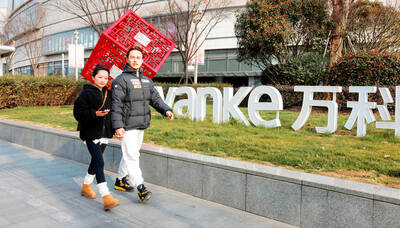The global shift of chipmaking factories to China is pushing up the demand for semiconductors in the whole Asia Pacific region, and Taiwan is part of that shift, according to US-based tech research firm Gartner Inc.
"In 2002, the Asia Pacific recorded the highest growth in revenues and was the largest semiconductor-consuming region, accounting for slightly more than one-third of global revenues," Philip Koh, a senior analyst at Dataquest Inc, a unit of Gartner, said in a statement. "China/Hong Kong and South Korea will continue to lead the region, while we expect to see more Taiwanese electronic equipment manufacturers shifting their high-volume, low-end production to China, in particular."
Semiconductors are chips of silicon used in devices as diverse as computers, mobile phones, printers and answer machines.
Last year, the Asia Pacific semiconductor market was worth US$57.3 billion. It is forecast to grow 13.2 percent to US$64.9 billion this year, and will continue to grow at around 12 percent each year to reach almost US$104 billion by 2007, Gartner reported at the end of March. The world market for semiconductors last year topped US$140 billion.
Other semiconductor industry watchers have predicted growth of between 18 percent and 20 percent globally this year while non-Asian markets play catch up. US-based In-Stat/MDR, a tech industry watcher, calls for a growth rate of 18 percent in the chip market worldwide this year, while the US' Semiconductor Industry Association (SIA) calls for a slightly more optimistic 19.6 percent.
SIA notes that Asia Pacific recorded a 29-percent rise in chip sales last year while the global market saw a mere 1.3-percent growth rate. Chip sales declined 13 percent in the Americas, 8 percent in Japan and 8 percent in Europe from 2001 levels, SIA reported in February.
"Electronic equipment production continues an unprecedented migration to facilities in the Asia Pacific region," the report said.
China is the major generator of growth in the region.
"The China semiconductor market is expected to continue to grow faster than the rest of the world," said Dorothy Lai, Gartner's senior semiconductor analyst in Hong Kong. "Low cost labor and availability of raw materials will stimulate continuous shifting of electronic equipment production to China by global equipment manufacturers, which in turn will fuel demand for semiconductor device consumption in the country."
Taiwan's high-tech firms have been relocating to China since the early 1990s to take advantage of cheaper labor and utility costs. The government estimates that as of the end of last year, approximately US$30 billion in investments flowed across the Taiwan Strait, but many officials admit that the figure is vastly underestimated. The Investment Commission reported that China-bound investment grew by 39 percent last year alone to top US$3.86 billion compared to 2001. The true figure could be closer to U$60 billion to date, with one third of that attributable to tech firms.
Reliable figures for Taiwanese chip investments in China are not available.
The top three independent makers of made-to-order semiconductors in the world in order are Taiwan Semiconductor Manufacturing Co (TSMC, 台積電), Taiwan's United Microelectronics Corp (UMC, 聯電) and Singapore's Chartered Semiconductor Manufacturing. The three together gained 90 percent of worldwide revenues, with a further 20 or so independent chipmakers vying for the remaining 10 percent, In-Stat/MDR figures show.
"Total independent semiconductor foundry revenue growth continues to outpace that of the integrated device manufacturers, even in down years, such as this one, by a percentage ratio of about two-to-one," In-Stat/MDR reported earlier this month.
At the end of February, the Taiwan government gave TSMC the preliminary go-ahead to build a chipmaking fab in China. TSMC is expected to pass all political hurdles and set up an 8-inch fab by the end of this year, further adding to China's chip market next year.
* Last year, the Asia Pacific semiconductor market was worth US$57.3 billion.
* It is forecast to grow 13.2 percent to US$64.9 billion this year, and will continue to grow at around 12 percent each year to reach almost US$104 billion by 2007.

CHIP RACE: Three years of overbroad export controls drove foreign competitors to pursue their own AI chips, and ‘cost US taxpayers billions of dollars,’ Nvidia said China has figured out the US strategy for allowing it to buy Nvidia Corp’s H200s and is rejecting the artificial intelligence (AI) chip in favor of domestically developed semiconductors, White House AI adviser David Sacks said, citing news reports. US President Donald Trump on Monday said that he would allow shipments of Nvidia’s H200 chips to China, part of an administration effort backed by Sacks to challenge Chinese tech champions such as Huawei Technologies Co (華為) by bringing US competition to their home market. On Friday, Sacks signaled that he was uncertain about whether that approach would work. “They’re rejecting our chips,” Sacks

Taiwan’s long-term economic competitiveness will hinge not only on national champions like Taiwan Semiconductor Manufacturing Co. (TSMC, 台積電) but also on the widespread adoption of artificial intelligence (AI) and other emerging technologies, a US-based scholar has said. At a lecture in Taipei on Tuesday, Jeffrey Ding, assistant professor of political science at the George Washington University and author of "Technology and the Rise of Great Powers," argued that historical experience shows that general-purpose technologies (GPTs) — such as electricity, computers and now AI — shape long-term economic advantages through their diffusion across the broader economy. "What really matters is not who pioneers

BUBBLE? Only a handful of companies are seeing rapid revenue growth and higher valuations, and it is not enough to call the AI trend a transformation, an analyst said Artificial intelligence (AI) is entering a more challenging phase next year as companies move beyond experimentation and begin demanding clear financial returns from a technology that has delivered big gains to only a small group of early adopters, PricewaterhouseCoopers (PwC) Taiwan said yesterday. Most organizations have been able to justify AI investments through cost recovery or modest efficiency gains, but few have achieved meaningful revenue growth or long-term competitive advantage, the consultancy said in its 2026 AI Business Predictions report. This growing performance gap is forcing executives to reconsider how AI is deployed across their organizations, it said. “Many companies

China Vanke Co (萬科), China’s last major developer to have so far avoided default amid an unprecedented property crisis, has been left with little time to keep debt failure at bay after creditors spurned its proposal to push back a looming bond payment. Once China’s biggest homebuilder by sales, Vanke failed to obtain sufficient support for its plan to delay paying the 2 billion yuan (US$283.51 million) note due today, a filing to the National Association of Financial Market Institutional Investors showed late on Saturday. The proposal, along with two others on the ballot, would have allowed a one-year extension. All three